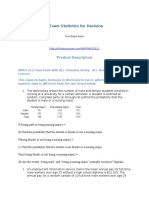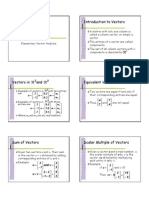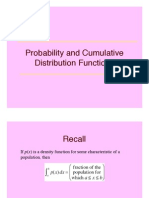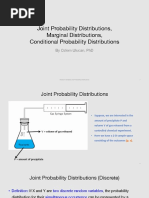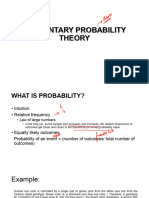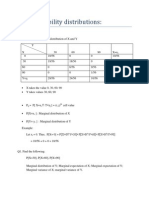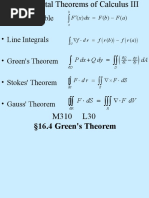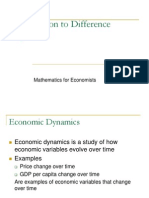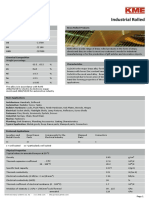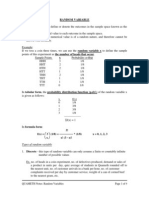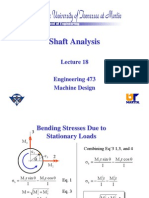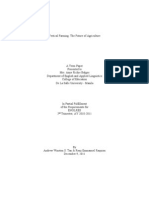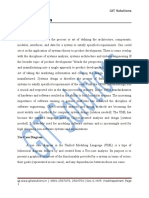3random Variable - Joint PDF Notes PDF
Uploaded by
Andrew Tan3random Variable - Joint PDF Notes PDF
Uploaded by
Andrew TanRANDOM VARIABLE AND
JOINT PROBABILITY DISTRIBUTION
RANDOM VARIABLE
It is an item used to define or denote the outcomes in the sample
space known as the sample points.
It assigns a numerical value to each outcome in the sample space.
It is an item whose numerical value is of a random nature, and
therefore cannot be known with certainty.
Types of random variable
Discrete - this type of random variable can only assume a finite or
countable infinite number of possible values
Continuous - this type of random variable can take on any value
within a given range
Ex. temperature, volume, weight, diameter, time, quiz average of a
student
PROBABILITY DISTRIBUTION
a table or a function which helps us determine or
compute the probability associated to each value of
the random variable
Types of Probability Distribution
1. Discrete probability distribution - one that involves a
discrete random variable
2. Continuous Probability Distribution - one that
involves a continuous random variable
DISCRETE PDF
Characteristics of a discrete probability distribution
1. f(x) > 0 x (for all x)
2. Ef(x) = 1
3. P(X = x) = f(x) refers to the value of the function when
the random variable X is equal to a specific value x
Cumulative Distribution Function
a table or a function that determines the probability that
the random variable X takes on values that are less than or
equal to a specific value x
denoted by: F(x) = P(X s x) = f(x)
CONTINUOUS PDF
Characteristics of a continuous probability distribution
1. f(x) > 0
2. If P(X = c) = 0 then P(a s x s b) = P(a < x s b) = P(a s x < b) = P(a < x < b)
3. .
4. .
Note: The total area under the curve represents the probability of the entire
sample space.
Cumulative Density Function
P(x s A) = F(A); P(x > A) = 1 - F(A); P(A s x s B) = F(B) - F(A)
}
= s s
b
a
dx x f b x a P ) ( ) (
}
=1 ) ( dx x f
}
= s =
x
dt t f x X P x F ) ( ( ) (
EXPECTATION
EXPECTATION, E(x) or
x
The expected value of the random variable x is the
average of all possible values of x or the mean of the x
values. It is one of the properties of a probability
distribution.
For discrete probability distributions : E(x) = x f(x)
For continuous probability distributions: E(x) = } x f(x) dx
VARIANCE
VARIANCE, (o
2
x
)
measures the dispersion or spread of the values of x
the average of the squares of the deviations of all the x values
from the mean
just like
x
, o
2
x
is a property of the probability distribution of x
Basic Formula: o
2
x
= E(x -
x
)
2
Working Formula: o
2
x
= E(x
2
) - (
x
)
2
= E(x
2
) - |E(x)|
2
Note:
x
and o
2
x
are measures that provide description to a
population.
Standard Deviation (o
x
): o
x
= (o
2
x
)
1/2
Example # 1
Let d represent the number of defectives produced in an
hours run by a particular automatic machine. The probability
distribution of d is given by:
1. What is the probability that in an hours run, the machine
will produce at least 3 defectives?
2. Answer (a) if it is known that the machine does produce at
least one defect.
3. Set up F(d) and use it to evaluate P(1 s d s 4).
4. Find the mean and variance of the number of defects
produced in an hours run.
=
0
) 6 (
10 . 0
) (
d k
kd
x f
elsewhere
d
d
d
5 , 4
3 , 2 , 1
0
=
=
=
Example #2
The random variable x has a density function
given by:
1. Find P(0.5 < x < 2)
2. Find P(x > 1.5)
3. Find F(x)
4. Use F(x) to evaluate P(x > 2) and P(1< x < 2.5)
5. Find and o
2
+
=
0
) 1 (
) (
x k
x f
elsewhere
x 2 0 s s
Example #3
From a box containing 5 red chips and 8 blue
chips, three chips are drawn in succession. Find
the probability distribution for the number of
blue chips selected if:
1. sampling is done with replacement
2. sampling is done without replacement
Example #4
The sales X of a gasoline distributor has a uniform
distribution shown in the figure below. Because of daily
equipment limitations, sales will never be less than 5,000
gallons per day and never greater than 25,000 gallon per
day.
Find the probability that the distributor sells
1. at least 20,000 gallons
2. between 15,000 and 23,000 gallons using F(x)
5,000 25,000
f(x)
Example #5
Let X be a random variable whose probability
distribution is given by
for 0 s X s 12
1. Confirm that the function is a probability
function
2. Find its expected value and variance and
standard deviation
72 6
1
) (
x
x f =
Assignment
The probability distribution of sales of a new drug in units
per day is given by:
1. What is the probability of selling 2 units of the drug in
one day?
2. What is the probability that at least 3 units are sold in
one day?
3. What is the probability that 3 units of the drug will be
sold within a period of 2 days?
4. Find F(x) in table form.
5. Use F(x) to evaluate the P(2 < x < 5) and P(x > 3).
=
0
) (
2
x
k
x f
elsewhere
x 6 , 5 , 4 , 3 , 2 , 1 =
Assignment
From a box containing 5 red chips and 8 blue
chips, three chips are drawn in succession.
Derive the probability distribution of x (where: x
= number of trials performed before a blue chip
is obtained) if the experiment called for drawing
a chip from the box until a blue chip is obtained.
1. assume sampling with replacement
2. assume sampling without replacement
Assignment
A box of a dozen eggs contains 7 good eggs and 5 bad
eggs. Mr. Thomas Cook is preparing breakfast for his
family - one wife and two kids. He plans to cook an egg
for each one of them plus some bacon. He randomly
selects 4 eggs from the box and sets these aside in a
bowl.
1. Determine the probability distribution function of the
number of good eggs contained in the bowl.
2. What is the probability that the bowl contains at most
one bad egg?
3. What is the probability that Mr. Cook will have to get
eggs from the box again?
Assignment
An operations research analyst has found that
the cumulative distribution of a random variable
is given by:
F(x) = x
2
/16 x = 1, 2, 3, 4
Reqd.: Find f(x)
Assignment
Find the cumulative density function of
f(x) = 3X
2
/125 0 s X s 5
Evaluate the ff:
1. P(Xs4)
2. P(X>3)
3. P( 2sXs3.5)
JOINT PROBABILITY DISTRIBUTION
Examples of Joint random variables:
The X number of hours watching TV as related to the Y
number of hours spent exercising.
The X number of books borrowed by a student per
term from the Library and the number of Y Journal
articles she photocopies.
X number of pages on a report and Y grade given by
teacher.
X minutes spent on a sports activity and Y number of
blisters created.
X hours spent at studying and Y grade of student in that
course
JOINT PROBABILITY DISTRIBUTION
Let x and y be two different discrete random
variables.
f(x, y)
joint probability distribution functionof x and y
probability distribution of the simultaneous
occurrence of x and y; i.e., f(x, y) = P(X = x, Y = y)
gives the probability distribution that outcomes x
and y can occur at the same time
DISCRETE JPDF
Characteristics of a Joint Probability Distribution for
DISCRETE RANDOM VARIABLE
1. f(x, y) > 0 for all (x, y)
2. f(x, y) = 1 add up the probabilities of all possible
combinations of x and y within the range and they
add up to 1.
3. f(x, y) = P(X = x, Y = y)
4. For any region A in the x y plane,
P [(x, y) c A] = E E f(x, y)
x
y
MARGINAL DISTRIBUTION
DISCRETE CASE:
g(x) =
h(y) =
y
y x f ) , (
x
y x f ) , (
CONDITIONAL DISTRIBUTION
DISCRETE CASE:
P ( Y= y) / X = x ) =
P ( X= x) / Y = y ) =
) (
) , (
) (
) , (
x g
y x f
x X P
y Y x X P
=
=
= =
) (
) , (
) (
) , (
y h
y x f
y Y P
y Y x X P
=
=
= =
COVARIANCE
Covariance Cov(x,y): A measure of dispersion
between joint variables X and Y.
COV(x,y) = E(xy) E(x) E(y)
where:
E(xy) =
E(x) =
E(y) =
y x
y x f y x ) , (
) (x xg
) ( y yh
Example #6
The following joint probability table for X and Y is presented:
Find
1. g(X)
2. P(X s 2|Y=0)
3. h(Y)
4. P(Y s 2|X=2)
5. Cov(XY)
Y
X 0
2
4
6
0 0.15 0.08 0.05 0.02
1 0.10 0.10 0.15 0.05
2 0.05 0.08 0.05 0.03
3 0.02 0.03 0.02 0.02
Example # 7
Two refills for a ballpoint pen are selected at random from a box
containing 3 blue refills, 2 red refills and 3 green refills. If X is the
number of blue refills and Y is the number of red refills selected,
find the joint probability distribution function f(x, y)
1. What is the probability that 1 blue refill will be chosen?
2. What is the probability that a red and a blue will be chosen?
3. What is the probability that no red refill will be selected?
4. What is the probability that I will get at least one blue refill
when you did not get any red?
5. Find the Covariance
Assignment
The following joint probability table for X and Y. Find
the covariance of X and Y.
Y
X
0 1 2 3
0 0.15 0.05 0 0
1 0.05 0.20 0.05 0
2 0 0 0.30 0.20
Assignment
The numbers 1 to 5 are written on pieces of
paper and placed inside a drawing box. 2
numbers are picked and their numbers are
recorded. Let X be the number of odd
numbered papers picked, and Y= the sum of the
2 numbers. Produce the joint probability table.
CONTINUOUS JPDF
Characteristics of a Joint Probability Distribution for CONTINUOUS
RANDOM VARIABLE
1. f(x, y) > 0
2. f(x, y) dx dy = 1
where U=upper limit; L=lower limit
3. P [ (X, Y) c A] = f(x, y) dx dy for any region A in the x y plane
Note: f(x, y) - surface lying above the x y plane
Probability - volume of the right cylinder bounded by the base A
and the surface
}
U
L
}
U
L
}
A
}
MARGINAL DISTRIBUTION
CONTINUOUS CASE:
g(x) =
h(y) =
Uy
Ly
f(x, y) dy
}
Ux
Lx
f(x, y) dx
CONDITIONAL DISTRIBUTION
CONTINUOUS CASE:
P (a < x < b / Y = y) =
}
b
a
f (x / y) dx
P (a < y < b / X = x) =
}
b
a
f (y / x) dy
Example #8
A candy company distributes boxes of chocolates with a mixture
of creams, toffees and nuts coated in both light and dark
chocolate. For a randomly selected box, let X and Y, respectively
be the proportion of the light and dark chocolates that are
creams and suppose that the joint density function is given by:
f(x, y) = (2/5)(2x + 3y) 0 s x s 1, 0 s y s 1
= 0 elsewhere
1. Find P [ (X, Y) c A] where A is the region { (x, y) |0 < x < ,
0 < y < }
2. Derive g(x) and h(y)
3. Find the conditional probability distribution of X, given that Y
= 1 for Problem 1 and use it to evaluate P (0 < x < 0.15 /
0.25<y< 1).
Assignment
Jollibee fast food branch operates both a drive-up facility and a
walk-in counter. On a randomly selected day, let X = be the
proportion of time that the drive up facility is in use (at least one
customer is being served or waiting to be served) and Y = be the
proportion of time that the walk-in counter is in use. Suppose
that the joint pdf of X and Y is given by
f(x,y) = 6/5 (x+y
2
) for 0 s X s 1 and 0 s Y s 1
1. Prove that the function is a legitimate pdf.
2. Give the marginal probability function of X and marginal
probability function of Y
3. What is the probability that both facilities are busy up than to
25% of the time.
Assignment
Each front tire on a particular type of vehicle is supposed to
be filled to a pressure of 26 psi. Suppose that the actual air
pressure in each tire is a random variable X for the right
tire, and Y for the left tire, with joint pdf:
f(x,y) = (3/380,000) (X
2
+Y
2
) for 20sXs30 and 20sYs30
1. Give the marginal probability distribution of the right tire
alone.
2. Give the probability that the left tire is underfillled.
3. Give the probability that the right tire is underfilled.
4. What is the probability that both tires are underfilled?
5. Are X and Y independent random variables?
You might also like
- MATH 221 Final Exam Statistics For DecisionNo ratings yetMATH 221 Final Exam Statistics For Decision8 pages
- Differential Equations (Calculus) Mathematics E-Book For Public ExamsFrom EverandDifferential Equations (Calculus) Mathematics E-Book For Public Exams5/5 (1)
- Joint and Conditional Probability DistributionsNo ratings yetJoint and Conditional Probability Distributions52 pages
- Limit Theorems: By: Ivan Sutresno Hadi SujotoNo ratings yetLimit Theorems: By: Ivan Sutresno Hadi Sujoto19 pages
- X X F DX X F: Applications of Integration Plane Areas by IntegrationNo ratings yetX X F DX X F: Applications of Integration Plane Areas by Integration17 pages
- Eigen Values, Eigen Vectors - Afzaal - 1No ratings yetEigen Values, Eigen Vectors - Afzaal - 181 pages
- MODULE 4 Part 2-Integral Calculus - Updated100% (1)MODULE 4 Part 2-Integral Calculus - Updated13 pages
- Unit 3 - DISCRETE AND CONTINOUS PROBABILITY DISTRIBUTIONS PDFNo ratings yetUnit 3 - DISCRETE AND CONTINOUS PROBABILITY DISTRIBUTIONS PDF37 pages
- Week - 4 - Joint Probability Distributions, Marginal Distributions, Conditional Probability Distributions100% (1)Week - 4 - Joint Probability Distributions, Marginal Distributions, Conditional Probability Distributions21 pages
- Use of Linear Functions for Modeling in Real-worldNo ratings yetUse of Linear Functions for Modeling in Real-world11 pages
- 3 - Electric Flux Density - Gauss Law - DivergenceNo ratings yet3 - Electric Flux Density - Gauss Law - Divergence31 pages
- Chapter5: Joint Probability DistributionsNo ratings yetChapter5: Joint Probability Distributions39 pages
- 5 Numerical Differentiation and Integration Newton Cotes IntegrationNo ratings yet5 Numerical Differentiation and Integration Newton Cotes Integration45 pages
- Single Variable - Line Integrals - Green's Theorem - Stokes' Theorem - Gauss' TheoremNo ratings yetSingle Variable - Line Integrals - Green's Theorem - Stokes' Theorem - Gauss' Theorem16 pages
- Section 4.4 Non-Homogeneous Heat EquationNo ratings yetSection 4.4 Non-Homogeneous Heat Equation6 pages
- Lecture 9 Introduction To Difference EquationsNo ratings yetLecture 9 Introduction To Difference Equations55 pages
- 1.3 Predicates and Quantifiers: Uniqueness Quantifier Quantifiers With Restricted DomainsNo ratings yet1.3 Predicates and Quantifiers: Uniqueness Quantifier Quantifiers With Restricted Domains7 pages
- Review of Basic Probability: 1.1 Random Variables and DistributionsNo ratings yetReview of Basic Probability: 1.1 Random Variables and Distributions8 pages
- Definite Integral (Calculus) Mathematics E-Book For Public ExamsFrom EverandDefinite Integral (Calculus) Mathematics E-Book For Public Exams4/5 (2)
- Inverse Trigonometric Functions (Trigonometry) Mathematics Question BankFrom EverandInverse Trigonometric Functions (Trigonometry) Mathematics Question BankNo ratings yet
- Brush Erosion-Dissolution Mechanical MachiningNo ratings yetBrush Erosion-Dissolution Mechanical Machining8 pages
- Agricultural Robots - An Economic Feasibility StudyNo ratings yetAgricultural Robots - An Economic Feasibility Study8 pages
- Const Int Const Int: Ledpin 13 Buttonpin 17No ratings yetConst Int Const Int: Ledpin 13 Buttonpin 172 pages
- Shielded Metal Arc Welding: By: Charles Lu Derwin Li Andrew Tan Renz Raquion Emil WangNo ratings yetShielded Metal Arc Welding: By: Charles Lu Derwin Li Andrew Tan Renz Raquion Emil Wang44 pages
- Vertical Farming: The Future of AgricultureNo ratings yetVertical Farming: The Future of Agriculture12 pages
- Shielded Metal Arc Welding: By: Charles Lu Derwin Li Andrew Tan Renz Raquion Emil WangNo ratings yetShielded Metal Arc Welding: By: Charles Lu Derwin Li Andrew Tan Renz Raquion Emil Wang44 pages
- Introduction To The Theory of Computation-L1No ratings yetIntroduction To The Theory of Computation-L15 pages
- Continuous Random Variables and Probability DistributionNo ratings yetContinuous Random Variables and Probability Distribution37 pages
- Discrete Probability Distribution & Continuous Probability Distribution - DPPNo ratings yetDiscrete Probability Distribution & Continuous Probability Distribution - DPP6 pages
- Paavai College of Engineering, Pachal Department of Computer Science and Engineering Internal Test-1No ratings yetPaavai College of Engineering, Pachal Department of Computer Science and Engineering Internal Test-11 page
- Introduction To Natural Language Processing: by Rohit SharmaNo ratings yetIntroduction To Natural Language Processing: by Rohit Sharma8 pages
- Theory of Automata Unit 1 Handwritten NotesNo ratings yetTheory of Automata Unit 1 Handwritten Notes20 pages
- Pretrained Convolutional Neural Network - MATLAB & Simulink - MathWorks IndiaNo ratings yetPretrained Convolutional Neural Network - MATLAB & Simulink - MathWorks India3 pages
- Differential Equations (Calculus) Mathematics E-Book For Public ExamsFrom EverandDifferential Equations (Calculus) Mathematics E-Book For Public Exams
- X X F DX X F: Applications of Integration Plane Areas by IntegrationX X F DX X F: Applications of Integration Plane Areas by Integration
- Unit 3 - DISCRETE AND CONTINOUS PROBABILITY DISTRIBUTIONS PDFUnit 3 - DISCRETE AND CONTINOUS PROBABILITY DISTRIBUTIONS PDF
- Week - 4 - Joint Probability Distributions, Marginal Distributions, Conditional Probability DistributionsWeek - 4 - Joint Probability Distributions, Marginal Distributions, Conditional Probability Distributions
- Use of Linear Functions for Modeling in Real-worldUse of Linear Functions for Modeling in Real-world
- 3 - Electric Flux Density - Gauss Law - Divergence3 - Electric Flux Density - Gauss Law - Divergence
- 5 Numerical Differentiation and Integration Newton Cotes Integration5 Numerical Differentiation and Integration Newton Cotes Integration
- Single Variable - Line Integrals - Green's Theorem - Stokes' Theorem - Gauss' TheoremSingle Variable - Line Integrals - Green's Theorem - Stokes' Theorem - Gauss' Theorem
- 1.3 Predicates and Quantifiers: Uniqueness Quantifier Quantifiers With Restricted Domains1.3 Predicates and Quantifiers: Uniqueness Quantifier Quantifiers With Restricted Domains
- Review of Basic Probability: 1.1 Random Variables and DistributionsReview of Basic Probability: 1.1 Random Variables and Distributions
- Definite Integral (Calculus) Mathematics E-Book For Public ExamsFrom EverandDefinite Integral (Calculus) Mathematics E-Book For Public Exams
- Inverse Trigonometric Functions (Trigonometry) Mathematics Question BankFrom EverandInverse Trigonometric Functions (Trigonometry) Mathematics Question Bank
- Agricultural Robots - An Economic Feasibility StudyAgricultural Robots - An Economic Feasibility Study
- Shielded Metal Arc Welding: By: Charles Lu Derwin Li Andrew Tan Renz Raquion Emil WangShielded Metal Arc Welding: By: Charles Lu Derwin Li Andrew Tan Renz Raquion Emil Wang
- Shielded Metal Arc Welding: By: Charles Lu Derwin Li Andrew Tan Renz Raquion Emil WangShielded Metal Arc Welding: By: Charles Lu Derwin Li Andrew Tan Renz Raquion Emil Wang
- Continuous Random Variables and Probability DistributionContinuous Random Variables and Probability Distribution
- Discrete Probability Distribution & Continuous Probability Distribution - DPPDiscrete Probability Distribution & Continuous Probability Distribution - DPP
- Paavai College of Engineering, Pachal Department of Computer Science and Engineering Internal Test-1Paavai College of Engineering, Pachal Department of Computer Science and Engineering Internal Test-1
- Introduction To Natural Language Processing: by Rohit SharmaIntroduction To Natural Language Processing: by Rohit Sharma
- Pretrained Convolutional Neural Network - MATLAB & Simulink - MathWorks IndiaPretrained Convolutional Neural Network - MATLAB & Simulink - MathWorks India

